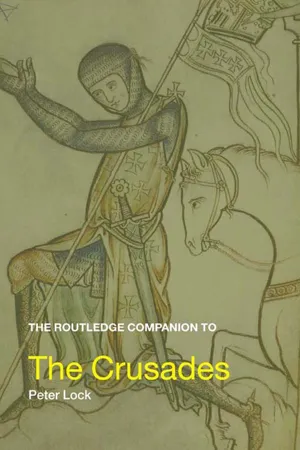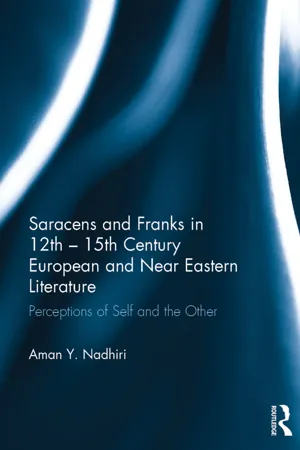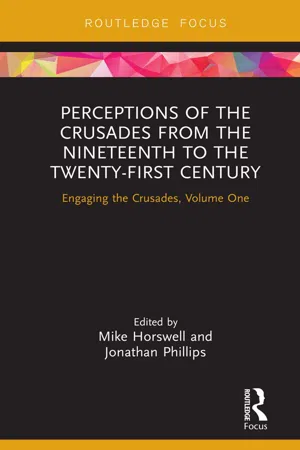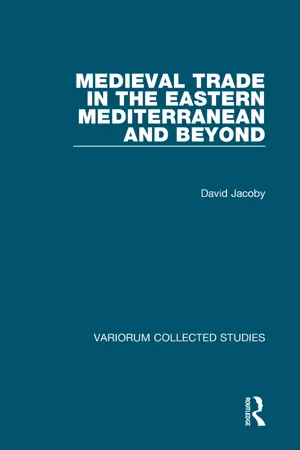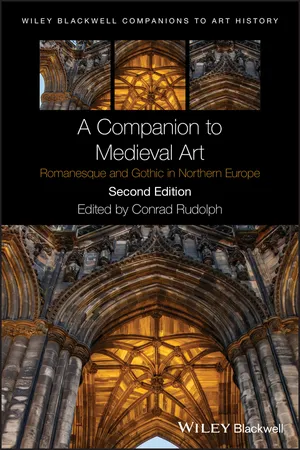History
Crusader states
The Crusader states were a group of feudal states established by Christian European crusaders in the Eastern Mediterranean during the 12th and 13th centuries. These states were set up in the aftermath of the First Crusade and included territories such as the Kingdom of Jerusalem, the County of Tripoli, the Principality of Antioch, and the County of Edessa. They played a significant role in the history of the Crusades.
Written by Perlego with AI-assistance
Related key terms
7 Key excerpts on "Crusader states"
- eBook - ePub
- Peter Lock(Author)
- 2013(Publication Date)
- Routledge(Publisher)
VI CRUSADES, CRUSADING AND THE Crusader states WHAT WAS A CRUSADE? The term ‘crusade’ is a modern not a medieval term. Its application as a title for the crusade movement seems to be no earlier than 1638 in Western Europe. Muslim sources did not distinguish between western pilgrims, crusaders, or settlers, labelling them all as Franks (al-Franj). It is only in the twentieth century that the literal term for crusade, al-salibiyyun, enters Arabic historical ‘riting. Interestingly, ‘rabic, Romance and Germanic words for ‘crusade’ derive etymologically from their word for ‘cross’, and thus emphasise the symbol of the cross in crusading activity 1 From the days of Gibbon there has been general agreement that the Crusades represented a turning point in European history, defining the nature of European identity and telling us as much about European medieval history as about the history of the Middle East. Until the present century this has led to a Eurocentric approach to crusading history. In the same vein Jewish historians thought that the Crusades exercised a profound influence on Jewish culture in Europe, and since the 1960s have traced the roots of the Holocaust back to the First ‘rusade. 2 Since the 1960s a debate regarding the unambiguous definition of the term ‘crusade’ has developed between the so-called traditionalists and the pluraliste The former hold that only those expeditions aimed at the recovery or defence of the Holy Land should be considered crusades, whilst the latter maintain that all expeditions authorised by the papacy with the concomitant crusade privileges, preaching and recruitment should be considered crusades. 3 The first approach privileges place — that is, the Holy Land — as the destination that made a true crusade. The second approach emphasises the procedural and organisational nature of crusading expeditions regardless of their destination - eBook - ePub
Saracens and Franks in 12th - 15th Century European and Near Eastern Literature
Perceptions of Self and the Other
- Aman Y. Nadhiri(Author)
- 2016(Publication Date)
- Routledge(Publisher)
7 Western Europeans in Muslim accounts of the Crusades The sudden appearance of thousands of soldiers from Western Europe in the Levant in 1097 was both wholly unexpected and militarily and politically devastating for the Muslims of the area. As a region, the Levant was disorganized, fragmented, and militarily vulnerable to outside interference, and had been so for a few years; the result of the Western European invasion was a number of sweeping, stunning European victories, and the establishment of “Crusader states” in relatively short order. The newly established Latin Kingdom of Jerusalem (comprised of Jerusalem, Antioch, Tripoli, and Edessa) was protected militarily by its supply of European soldiers in the Levant and its access to reinforcements on continental Europe, and politically by both the support it received from Europe and by the inter-necine feuding between the Muslim leaders in the surrounding areas, who appeared to prefer the existence of a kingdom ruled by Christian Europeans to the prospect of a Muslim ruler increasing his sphere of influence through the recovery of the Crusader-controlled areas at the expense of the territorial integrity of his Muslim neighbors. 1 The lack of unity among the Muslims not only ensured the continued existence of the Crusader states, it allowed for their expansion in the early twelfth century, as other parts of the surrounding area were conquered by the Crusaders, thus strengthening the nascent European community in the Levant - eBook - ePub
Towards the Prophetic Church
A Study of Christian Mission
- Hull(Author)
- 2014(Publication Date)
- SCM Press(Publisher)
It has now become clearer that very few Crusaders gained material benefit from their activities (Tyerman 1988, p. 18). Indeed, on the contrary, many individuals and families made considerable sacrifices to fulfil what they came to see as their religious duty to go on armed pilgrimage. Many people still think of the Crusades as expeditions aimed at the recovery or defence of Palestine, but it has become clearer that crusading was a far more general phenomenon. ‘It is now clear that the fourteenth century, like the thirteenth, was one in which there was hardly a year in which a crusade was not being waged somewhere’ (Riley-Smith 2009, p. x).The recovery of the Iberian Peninsula from the Moors, which began in a significant way with the Battle of Tours won by the Franks in 732, and was not complete until the fall of Granada in 1492, occupying nearly 800 years, was again and again blessed by the popes and given the status of a Crusade (Riley-Smith 1981, pp. 15–16). The Northern Crusades fought against the Baltic and eastern European countries between the twelfth and fourteenth centuries in which the military orders played a prominent part, were given the status of Crusades from the time of Pope Celestine III in 1193 (Christiansen 1997). There were Crusades against secular authorities and against fellow Christians in southern Germany and in south-western France.In understanding this we must consider the prevailing political philosophy in which Christendom was ‘seen not merely as a society of Christians but as a universal state, the Christian Republic, transcendental in that it existed at the same time in heaven and on earth’ (Riley-Smith 2009, p. 24). This universal state had been established by Christ for the benefit of all humanity. It was not only a Christian republic; it was a monarchy of which Christ was the King (p. 25). - eBook - ePub
Perceptions of the Crusades from the Nineteenth to the Twenty-First Century
Engaging the Crusades, Volume One
- Mike Horswell, Jonathan Phillips(Authors)
- 2018(Publication Date)
- Routledge(Publisher)
4 ‘Unity! Unity between all the inhabitants of our lands!’The memory and legacy of the crusades and Saladin in the Near East, c .1880 to c .1925Jonathan PhillipsAcross the closing decades of the nineteenth century, and comfortably into the early twentieth, major changes in political and cultural life across the Near East offered the region’s many interested parties tremendous scope to look back to, and to draw upon, their memories of the crusades. Contrary to earlier thinking it is clear that the Muslim Near East had not forgotten the conflicts of the medieval era and had indeed preserved an understanding of the crusading period down through the centuries.1 It is also apparent that from the time of Napoleon’s invasion of Egypt (1798) the weakening of the Ottoman Empire led European powers to exert a growing influence in the region. Events such as the French conquest of Algeria (1830) and from the 1840s the return of a significant Western presence in the holy city of Jerusalem (for the first time since 1244) being but two examples of this. Rising tensions between Christians and Muslims, such as the 1860 massacre in Damascus, were another part of the wider context. In such circumstances, the period under consideration here was a particularly fertile time for people in the Near East to see the history of the medieval crusades as a precedent for contemporary Western invasions. They also sought a role model in the form of Saladin, the man who recovered Jerusalem from the Franks in 1187, to emulate and to remind themselves that the crusaders had been defeated and expelled.It is also relevant to note that some Westerners, including those taking part in military campaigns, living in the Levant or who were there as peaceful visitors to the area (especially the holy places of Palestine), chose to represent themselves as crusaders and regarded their own actions as being in the footsteps of crusading ancestors. In part this runs alongside, and is deeply intertwined with, a revival of interest in the medieval period and the crusades in Western Europe, both major subjects in their own right.2 - John France(Author)
- 2002(Publication Date)
- Routledge(Publisher)
9After the triumph of the First Crusade in 1099, the crusade became an established institution of the medieval West. The papacy directed crusaders to many different places at different times. Here we are concerned with what was always its most characteristic purpose, the maintenance of Latin domination over the Holy Land. To achieve this end, the crusade was an imperfect instrument. Crusading came in fits and starts, often with long intervals in between. The absence of a major effort after the failure of the Second Crusade undoubtedly helped the Islamic powers in their assault on the crusader principalities. All who took the cross did so as individuals, and, theoretically were equals. In fact, the social structure of Europe persisted in the crusader armies, but this left the problem of command.The First Crusade was led by a committee of princes, and it was only in extreme circumstances that the leaders agreed to the appointment of a single commander - and then only for a limited period. Serious strains arose after the fall of Antioch in 1098, to such an extent that the siege of Jerusalem was undertaken by what were virtually two armies. The crusade of 1101 involved huge numbers of troops, but they fought in separate contingents which were defeated by small numbers of Turks in Asia Minor. A similar fate overtook the Second Crusade, because Louis VII of France and Conrad III of Germany failed to work together. The quarrels of Richard and Philip Augustus delayed their departure for the Third Crusade and once there they failed to cooperate. After Philip had departed, Richard was a brilliant commander, but there were considerable tensions between the English, French and Germans, and prevalent attitudes in the army forced him to pursue the attack on Jerusalem when he might well have preferred to attack Egypt. In the end, he withdrew from Jerusalem because of the dangers of a siege in the face of a hostile army and the sheer difficulties of holding it once the crusade had departed. For this decision he was much reviled, but he had taken the best advice and he was almost certainly right.- David Jacoby(Author)
- 2017(Publication Date)
- Routledge(Publisher)
4 David JacobyThe Economic Function of the Crusader states of the Levant: a New ApproachFour Frankish states emerged in 1098–1099 in the Levant as a result of the First Crusade: the Kingdom of Jerusalem, the County of Tripoli, the Principality of Antioch, and the County of Edessa in northern Syria.1 The first three states, which extended along the Levantine coast, pursued their existence for more than a century and a half, although their borders changed repeatedly over time. The county of Edessa disappeared as early as 1150. This contraction of Frankish territory in the Levant was followed by a far more important one. In 1187 the Egyptian sultan Saladin defeated the Franks at the battle of Hattin, captured Jerusalem, and occupied large sections of the Frankish states. The Franks regained some territory in 1191–1192, in the wake of the Third Crusade, and again for two short periods in the first half of the thirteenth century. However, for most of that century they were limited to a strip of land along the Levantine seaboard. From 1265 onward the conquests made by the forces of Mamluk Egypt gradually reduced the territory of the Frankish states, and in 1291 they put an end to Frankish presence in the Levant.Various aspects of the economy of the Frankish Levant have been investigated. Most studies focus on maritime trade, following the lead provided by two great historians, Wilhelm Heyd and Adolf Schaube, whose respective books published in 1885–1886 and in 1906 paved the way for a detailed study of twelfth and thirteenth-century trade in the eastern Mediterranean, the period covering the existence of the Frankish states.2 Heyd and Schaube collected a considerable amount of information, yet exclusively from published sources. Their books remain indispensable, although much new evidence has come to light since they were published. The geographic and chronological range of Heyd’s work is broader, since in addition to the Mediterranean it covers the Black Sea and the Middle East and reaches the fifteenth century. On the other hand, Schaube limited himself to the Mediterranean and its fringe, which included the Frankish states, and to the period ending roughly in the mid-thirteenth century, before the full economic impact of the Mongol expansion was felt in the Levant. The two authors nevertheless shared the same approach, molded by the prevailing political and economic concepts of their times, the colonial era. Their emphasis was upon the expansion of the western maritime powers in the eastern Mediterranean, long-range trade and shipping, and the activity of traveling merchants. They treated separately each of the regions bordering the eastern Mediterranean, namely, Byzantium, the Frankish states, and the states of the Islamic East, in a context of bi-lateral commercial exchanges and shipping links between West and each of the eastern political entities. Heyd and Schaube viewed the trans-Mediterranean trade system as operating according to a ‘colonial’ pattern, in which the West had a dominant and dynamic role and exploited the resources of the underdeveloped eastern Mediterranean regions, including the Frankish states, which merely reacted to western stimulus and had an essentially limited function: they produced certain foodstuffs and raw materials, as well as some industrial commodities and mainly served as intermediaries between the West and Islamic Asia, which provided Oriental commodities largely in exchange of Western finished products. Within that framework the two historians considered the Frankish Levant a political and economic extension of Europe, at the edge of the region in which the West expanded. They viewed the Frankish settlers as western colonizers mainly furthering the interests of their respective cities of origin. The Eurocentric and bi-polar perspective adopted by Heyd and Schaube appears to be justified by the extant evidence, which will soon be examined. Their approach has been widely shared in the past and still is nowadays.3- eBook - ePub
A Companion to Medieval Art
Romanesque and Gothic in Northern Europe
- Conrad Rudolph(Author)
- 2019(Publication Date)
- Wiley-Blackwell(Publisher)
29 East Meets West : The Art and Architecture of the Crusader states Jaroslav FoldaIntroduction
Historiographically the origins of the modern study of Crusader architecture and art can be located in French scholarship during the nineteenth century. The beginnings of the modern European rediscovery of Syria‐Palestine are associated with the scholars who followed Napoleon's campaigns in the Near East from May 1798 to August 1799. Shortly thereafter, J.F. Michaud began the publication of his Histoire des croisades, starting in 1812.1 Study of the material culture of the Crusaders was begun in terms of coinage, and the first attempt at a comprehensive study appeared in 1847 by Louis Félicien de Saulcy.2 Interest in the Crusaders was indirectly intensified in France during the Crimean War (1853–1856), in which one of the major issues was French protection of Christian pilgrims to Jerusalem and the holy sites under the Capitulations of 1620 and 1740, firmans signed by the Ottoman sultan. Four years after the end of the war, the count Charles‐Jean‐Melchior de Vogüé (1829–1916), published a pioneering study entitled Les Eglises de la terre sainte.3 This book marked the beginning of modern research into the art and architecture of the Crusaders in the Holy Land.The Study of the Art of the Crusaders in the Late Nineteenth Century
De Vogüé approached the study of Crusader churches as the work of French architects who produced buildings in three phases: phase 1, in Syria‐Palestine from 1099 to 1187; phase 2, from 1187 to 1291; and phase 3, on Cyprus from the thirteenth to the fifteenth centuries. He argues for the importation of Romanesque architecture from western Europe as the basis of Crusader architecture, and he sees the development of Crusader art as controlled by French artistic ideals. But he was well aware of two aspects that influenced the architecture in its new setting: first, the local climate, materials, and masons, and second, the fact that the eastern Christians had their own distinctive architectural traditions.
Learn about this page
Index pages curate the most relevant extracts from our library of academic textbooks. They’ve been created using an in-house natural language model (NLM), each adding context and meaning to key research topics.
